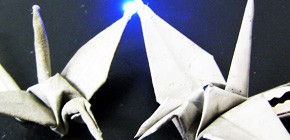
Origami electronics
a step in the development of light wearable computers using nanopaper and nanowires
Under the leadership of NOGI Masaya , Associate Professor, Institute of Scientific and Industrial Research , Osaka University, a group of researchers has developed a new kind of origami [Japanese folding paper] that can be folded while maintaining embedded electronic functions.
Electronic devices such as smartphones, while getting lighter and thinner, are densely packed with many parts. In order to further reduce size and weight, the development of foldable components with advanced functions is a major challenge for future electronics. Furthermore, recently many electronic devices come equipped with an antenna for receiving and/or sending electronic signals. However, as devices decrease in size, sufficient space for an antenna becomes a problem for such densely packed devices. Thus, foldable antennas that can be squeezed into a small space are needed.
This group decided to turn to origami, Japanese folding paper, an art that has been popular in Japan for a long time, for a solution to these problems. Their challenges were to make a new type of paper which could then be used for constructing foldable paper antennas. The "nanopaper" they developed was made using cellulose nanofibers. Silver nanowire lines were afixed to the nanopaper, making the foldable antenna. This nanopaper was capable of being folded while maintaining nanowire conductivity.
By using nanopaper, heavy substrate materials such as glass and silicon wafers become unnecessary and electronic devices can become lighter. Furthermore, if sheets of nanopaper can be folded into intricate structures while maintaining their conductivity, foldable electronic devices will become a reality. This newly developed technology, based upon the concept of origami electronics, will possibly lead to the development of wearable computers, medical sensors, and other devices.
Abstract
Foldable antennas are required for small-sized electronic devices with high portability. Antennas on plastic substrates provide high flexibility and high sensitivity but are not foldable. Antennas on paper substrates are foldable, but their sensitivity is poor because of their coarse surfaces. In this paper, nanopapers with smooth surfaces and high foldability are fabricated from 30 nm wide cellulose nanofibers for use as foldable antenna substrates. Silver nanowires are then printed on the nanopapers to act as antenna lines. These nanopaper antennas with silver nanowires exhibit high sensitivity because of their smooth surfaces and high foldability because of their network structures. Also, their high foldability allows the mechanical tuning of their resonance points over a wide frequency range without using additional components such as condensers and coils. Nanopaper antennas with silver nanowires are therefore suitable for the realization of future foldable electronics.

Figure1

Figure 2
To learn more about this research, please read the full research report entitled " Foldable nanopaper antennas for origami electronics " at this page of the RSC Publishing website.
Related links :
